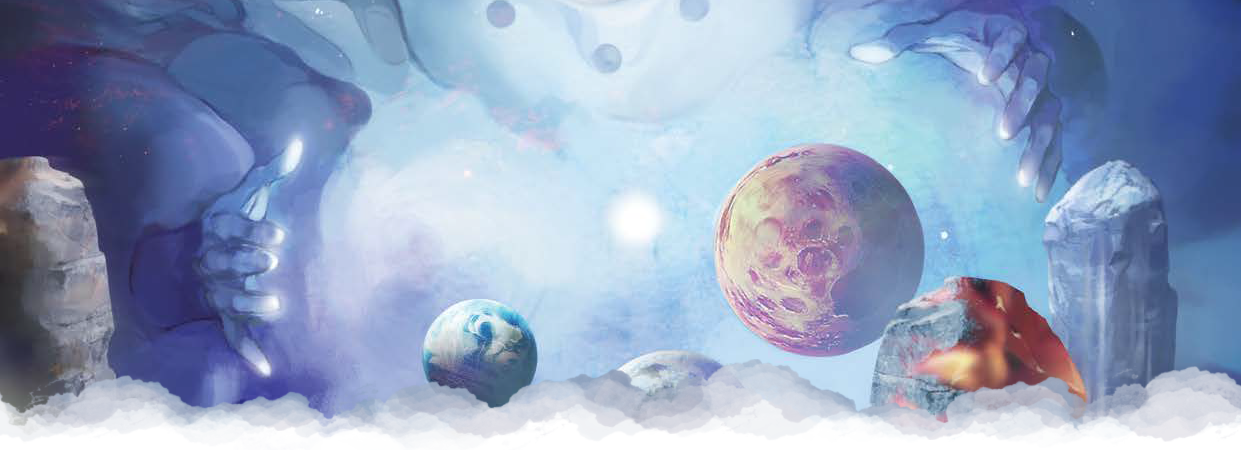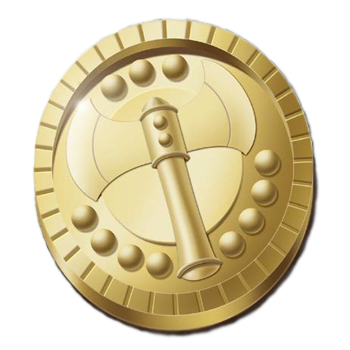Terak
God of War and Valor
Terak (TAIR-ack) is the god of the body, valor, war, physical struggle, brotherly unity, and battle. He is worshiped by soldiers and warriors of all stripes, those who need the protection of physical strength, and protectors of the weak.
Terak is shown as a powerful figure, broad of shoulder and with a great barrel chest. His hair falls to his knees and is either braided or left loose, depending on the culture that made the icon. He is also usually with with a long beard, blonde hair and icy blue eyes. He is often armored, always carries his battle axe, and is represented wearing a cloak of fur and bones—bones taken from his son, Aerix.
He is associated loosely with animals of war like dogs, horses, and hawks, but his closest association is with the lion. He is served in the heavens by lamassus, the mystical creatuers with which he is often associated, and the children of his animal companion, Metteron.
Terak is worshiped most fervently by the mortal races that wage war in an organized and tactical manner: humans, dwarves and elves. Halflings, and gnomes certainly pay their respects to Terak as one of the gods, but his worship is not especially popular in their homes. Because of the religion's strict belief that all five mortal races are equal, the worship of Terak is incredibly popular with ostracized half-orcs and half-elves.
Terak is lawful neutral or lawful good. There is a pronounced rift among Terak's worshipers and holy orders. He is worshiped in two distinct ways and, depending on which group you ask, can be described as either alignment. Most religious scholars consider him lawful good, and his church primarily follows this alignment.
Divine Domains
War
Holy Books & Codes
Some of the oldest prayers to Terak are quite poetic, and still used. One prayer for soldiers before battle is so ancient that scholars are uncertain of its ultimate origin, with many maintaining that it is what Terak himself uttered before the final assault on Kador.
"I am the river and the mountain.
As the river, I rage in times of torrent,
And decrease in times of drought.
I swell to overflowing with my wrath,
And my rage is dry in calmer seasons.
None can control my run,
None can alter it.
None can stand against me.
As the mountain, I am strong.
I do not wax or wane.
Age shall never o'ercome me.
I will not be moved.
I will not be shaken.
I will not be broken.
I am the river and the mountain,
Unstoppable and unbreakable."
Divine Symbols & Sigils
Two symbols represent Terak. The first, used by those who follow the lawful neutral interpretation of his teachings, is the fasces: a bundle of sticks lashed together with a golden cord. When one is in a hurry, this symbol can be fashioned as several small circles around a central circle. This is used for stamps on weapons, low detail work, and hasty scrawls. This set of circles cast of bronze is often used as a holy symbol, even though it is not supposed to be.
The second symbol, and the one used by his lawful good worshipers, is Terak's axe. Forged in the first epoch and the first weapon made, the axe was used by Terak against his own brother and the tree of life, Eliwyn, but also against Kador, and the dark god's wicked progeny. The double-headed axe of Terak bespeaks this contradiction. Weapons have two sides. They can be used for great harm, or great good. This lesson is dear to Terak's lawful good followers. The simple version of the axe is a circle with a line that is moved from its top, through the middle, and past, to become the axe's handle where the circle stands for the blade.
The correct holy symbol of Terak, and the one worn by most of his faithful, is a bronze likeness of the axe. Someones one head of the axe is golden and the other, black, but this is an ornate symbol only worn by commanders and similarly powerful faithful.
Tenets of Faith
"There is no weakness that cannot be made strength, no frailty that cannot be made firm, save one: the weakness in our spirits that tells us we have done enough, that we may rest, that we have achieved all we can achieve. We must always strive, always improve, always struggle against weakness within, and without."The worship of Terak, and the schism dividing his faithful, can best be understood when one looks at the roots of the Teraketh faith. In the earliest days of the mortal races, Terak was worshiped as a god of strength and personal, physical struggle. From this religion the current church arose, and many of its oldest prayers are still common prayers in Terak's temples. The body is rebellious. It grows old and frail. It does not always work properly. The earliest cult of Terak was based on the overcoming of that rebelliousness—the imposition of order onto the body. As the religion matured, the body came to have greater meaning. It became the body of society, of nations, of the mortal races, and so on. Over the years, the faith of Terak has come to embody the following clear principles based on those earliest ideas, which today's faithful try to follow:— From the War Chants of Lord Commander Silas Redbrook
- All people of the five races are equal. Social rank, gender, or race does not make one person better than another. While there might be status in the world for good reasons, it must be earned by strength of character, not accidents of birth.
- The faithful must show only one face to his brothers and sisters. A follower of Terak must never knowingly lie to another person of one of the five mortal races. A worshiper must also never engage in adultery (defined as pre- or extra-marital sex). These restrictions are commonly broken by the faithful, other than those who belong to a holy order.
- The faithful must be true to their bodies and, thereby, Terak. This means the faithful must never:
- Cut their hair, except once when they reach maturity
- Get tattoos or other permanent marks on their bodies, though they can pierce their flesh for adornment
- Drink alcohol, smoke tobacco, or use any other intoxicant (this is routinely violated by the casual worshipers of Terak, particularly members of militias and armies)
- Eat the meat of any unnatural creature
- The faithful must shun the trappings of social superiority or elitism. They do not accept, demand, or give wedding dowries, nor do they refuse to marry or bar the marriage of their children based on class, status, or even race (many faithful fail to adhere to this, barring their children from marrying outside of their race). They do not raise elaborate markers on their graves, using simple stone etched with names instead. They do not associate with those who live off the work of others without working themselves. They cannot open a business unless they work at the business.
- The faithful must tithe once a month, giving a tenth of all they own to aid the sick and invalid.
- The faithful must bear the five symbols of the faith: the Unshorn Hair, the Vambrace, the Holy Symbol, a Weapon, and the Forelock.
- The faithful must constantly train their bodies and improve their martial skills to be prepared to defend the weak among their brethren.
Holidays
The temples of Terak do not celebrate any universal holy days. Instead, each regional council organizes celebrations of local holy days tied to local great battles. The temples take it upon themselves to commemorate all fallen heroes from such wars, regardless of their faiths.
Among each of the faithful there is one particularly important and holy day, which is the day of adulthood. Called the sword day (shortened to Sworday and pronounced Soreday, a favorite pun among those mocking the Teraketh), it marks the day when a member of the faith comes of age. The young boy or girl is given a family weapon, usually an axe or sword crafted just before his or her birth, but sometimes one passed down from generation to generation, and the child's head is shaved, removing the hair of youth. This is the only time the hair of the faithful is ever cut (though they can shave their faces) and the forelock from the occasion is shaved and carried by the Teraketh for the rest of their lives.
Once the weapon is bestowed and the head shaved, several stout warriors from the community gather around the newly minted adult and, depending on the culture, either beat him or her into unconsciousness against the adolescent's fierce opposition, or stage a ceremonial fight.
Divine Goals & Aspirations
Most myths and many scholarly works present Terak as a sort of knuckle-dragging, violent maniac. The reasons for this are simple: First, he really was a violent maniac in his youth, as were his siblings Tinel and Zheenkeef. Second, these sources are usually written by the worshipers of Tinel, Zheenkeef, or one of the other chaotic gods.
Terak is best understood as the wily king or general from a warrior culture. He sits on his throne pondering warfare and the strengths of nations. Elaborate aesthetics, matters of learning, and books hold little appeal for him. However, he is no longer the simpleton he is represented as. He loves sincere songs, and poems without double meanings or bits of hidden cleverness. He enjoys the simple pleasures a life of decency brings.
Since the death of his son Aerix, he has ceased pursuing the expansion of his personal power. In the past, Terak was a primitive god who sought glory, strength, and supremacy, which brought him into conflict with his brother Tinel. Now, while he is still in conflict with his brother, it is for different reasons.
Terak sees there is on thing that truly matters in the world: strength. While his brother Tinel puts faith in the strength of the individual and the power of knowledge, magic, and other abilities an individual might possess, Terak puts his faith in the power of the many. He sees true strength in a unified society. And while he sometimes makes it clear he opposes the use of that strength for evil, at other times he seems to support the power of unity without question. These mixed messages led to a schism among his followers that is generally cordial, but sometimes grows fiercely argumentative.
Terak wishes to see the mortal races unified. He would see a world where the will of the many prevails over the few. He is fondest of the common people, and those who protect and serve them, such as soldiers. He has little love for those who consider themselves superior because of their knowledge or magic, or because they possess greater wealth. He seems to have no problem with those who use their physical prowess to unify people against the elite and learned.
In Heaven, Terak is king because his wife is queen. He bears no special authority as king over his chaotic brother and sister—indeed, they resent his status. Terak would like to unite Heaven under goodness, but his pride keeps him from extending much friendship to Tinel.
Divine Classification
God of the Tree
Religions
Children
Remove these ads. Join the Worldbuilders Guild









